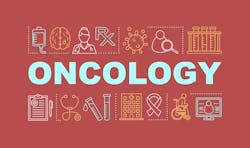A panel session at this week’s AMIA Symposium highlighted the potential benefits and challenges of implementing OpenNotes in cancer centers. Surveys by early implementers found that patients had a much higher opinion of the value of note sharing than clinicians did.
The “information blocking” rule that goes into effect in April 2021 requires all providers to make clinical notes available to patients electronically upon request, so whether or not health systems have participated in the “OpenNotes” movement previously, they soon will be required to by regulation. During the Nov. 17 panel session, physician leaders from Memorial Sloan Kettering Cancer Center in New York and Dana-Farber Cancer Institute in Boston described their early efforts to deploy OpenNotes in oncology settings.
Andrew Wagner, M.D., medical director of ambulatory oncology at Dana-Farber, said the cancer center moved to implement OpenNotes in 2016 as part of an enterprise effort at Partners HealthCare (now rebranded Mass General Brigham). In the fall of 2016 when they started socializing the idea with providers, they were met with several concerns. “One of the biggest was that there was not sufficient data about the experience in oncology,” Wagner said. There had been a few small studies, but nothing at the scope they were considering. The clinicians said that their notes were intended for communicating with each other but not as a tool to communicate with patients. “One person said we shouldn’t share our notes because they are really bad,” Wagner said with a laugh. “I don’t disagree, but that is not a reason not to share. We need to improve note quality,” he said, by cutting down on "note bloat" and decreasing the use of jargon.
But if clinicians had concerns, so did the patient and family advisory council. Some member were worried that patients would be prompted to read notes through the portal when they did not wish to do so. The organization chose not to send out a “tickler” email each time a new note was available.
Mass General Brigham did a survey of oncologists and other types of providers before going live in January 2017. The oncologists expressed concern that patients would reach out with questions about what was in the notes and that doctors and nurses would spend more of their time addressing concerns and confusion.
But when they went live, there was little impact because very few patients read the notes. Only 4 percent of notes that were shared were read. Wagner gave a few reasons. One is that patient portal enrollment overall is only 40 percent, and that within the portal, the notes section was difficult to navigate. Also, in oncology, patients may have many visits in a month or year, and often there is little new information presented in a note. “Our patient portal had some renovations a year ago that made it much easier to reach notes,” Wagner said. “It is less cumbersome, but not as good as it could be.”
Portal enrollment climbed to 70 percent this year due to the COVID pandemic and the use of telehealth, but the note read rates is still only about 10 percent.
With the information blocking regulation of the 21st Century Cures Act going into effect next April, organizations will have to start sharing many more types of notes, including notes of nurses, social workers, psychiatrists, therapists and others, and that will require more clinician education. “Information blocking is no longer permitted unless there is serious risk of physical harm to the patient,” Wagner said. That has raised a new concern. Typically the health system embargoed release of imaging and pathology results for seven days so clinicians could have a discussion with patients about the results before patients read the report. Now those results must be immediately released. “Immediate results access is a big concern,” he added.
Writing better notes and having better patient conversations
Everett Weiss, M.D., associate chief health information officer at Memorial Sloan Kettering Cancer Center, said that before implementing a change such as sharing clinical notes with patients, it was important that they had a chance to provide feedback and voice concerns, and get answers to their questions. One question he poses to people who are reluctant to make this shift is: what will happen if we don’t do it?
“What is the competition doing? If we don’t do it, are we going to be laggards? If this is about securing trust in the provider-patient relationship, what is the cost when other organizations are implementing it aggressively?
Weiss said he tries to stress that there is a big difference between result report release and note release. They convey a different type of information. The clinical note should be a summary or synthesis of what happened in a clinical visit — a conversation that has taken place. “Results happens between visits. The way we talk about visits is very different,” he said. “If we recognize the distinction, we can offer better support on how to write better notes and have better conversations with our patients.”
Catherine DesRoches, DrPH, executive director of the OpenNotes nonprofit organization at Beth Israel Deaconess Medical Center, said the organization has been collecting data comparing the views of clinicians in oncology and patients. Only 34 percent of clinicians said making notes available to patients online is a good idea, compared with 95 percent of patients with a cancer diagnosis. Only 11 percent of clinicians said reading notes helps patients prepare for visits, compared with 56 percent of patients. Asked whether notes are more confusing than helpful, 18 percent of clinicians said yes, compared to only 3 percent of patients.
Weiss said it is important to understand why clinicians have lower expectations for OpenNotes than patients do. “Do we understand what patients need or want from us?”
He wants health systems to think bigger about OpenNotes than just sharing what is in the EHR with patients, and use it as an opportunity to innovate to better engage with patients. “First, we are not infallible. Mistakes are made,” Weiss said. “If a patient notices a mistake, how do we streamline the process of fixing the record and help them facilitate making corrections?”
Weiss also suggested finding creative ways to make it easy for patients to understand some of the acronyms and jargon that end up in notes.
Another possibility is to allow patients to annotate notes between visits. Weiss asked if there could there be opportunities to increase their understanding what they are expected to do? Another possibility, he said, would be to make it easier for them to share the notes with family members and caregivers.
He suggested creating a shared knowledge library across organizations with tools about how to talk with patients about notes, how to document sensitive information, and how to better capture the patient conversation in notes so that there are no surprises when they read them. “The note is just a reflection of what transpired in a visit,” he said. “There are some very sensitive topics. If a clinicians is concerned that a patient will not be able to cope with very bad news, that should not be hidden from the patient, and it shouldn’t be a surprise when they read the note.”


